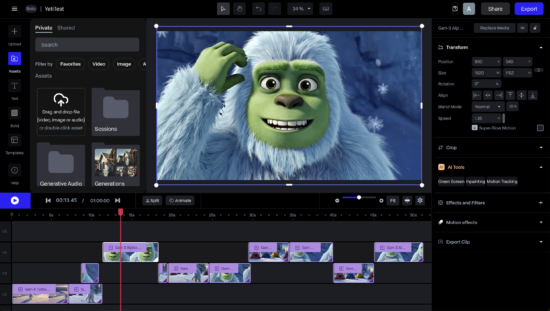So you’re looking to build a visual content strategy. Or, perhaps, you already have one in place and are searching for new opportunities to take it to that next level. Maybe you’ve never even thought of integrating visual content into your strategy until just now.
Regardless of where you find yourself, there are plenty of content types from which you can develop a solid strategy through visual storytelling — infographics, interactive design, motion graphics, GIFs, memes, social thumbnails, traditional data visualization, the list goes on. But before diving into the actual execution of a visual communication strategy, we should first look into where these design assets will be coming from as this is an often overlooked step that can play a major role in whether or not your visual communication strategy is successful.
When it comes to who will develop your visual content, you have a few options to choose from: in-house, freelance, or a design agency. Each of these will provide their own unique approach when it comes to the development and/or execution of a project, and choosing which avenue to take will be mainly driven by your content and visual communication goals.
In-House:
This option is definitely not for everyone as not everyone has the option of an in-house designer. But for those fortunate enough to have this in their back pocket, it’s a great place to get started!
Pros:
They’re In-House — An in-house designer provides a depth of company knowledge that outsourced work can sometimes fall short on. They know your brand, the industry, audience, major players and what works best for that particular niche in terms of captivating design. Also, with an in-house designer at your finger tips, one of the most beneficial attributes is having unfettered access to them. If project specs need to be changed or there’s a last minute asset addition, they’re only a hop, skip and jump away.
Cons:
Creative Restrictions — Unless you have a large in-house design team, it’s likely your in-house designer is a production designer, meaning they possess a broad range of general design skills to fulfill company needs but don’t necessarily have an intimate knowledge or expertise in a specific field of design — data visualization and infographics, UI/UX design, animation, brand strategy, etc. As a result, and through no fault of their own, in-house designers often get typecast into producing the same core deliverables on a regular basis. This redundancy limits their ability to flex their creative muscles and often restricts the creative process for all involved.
Best for:
If you’re working on internal projects that require strict branding guidelines, your in-house designer should definitely be involved. If they show a lot of raw talent, be sure to give them opportunities that go beyond status quo deliverables. Let them push their creative boundaries and grow their skills with the organization. Without these opportunities, you might lose your in-house designer to an agency that can offer more challenging work.
If you’re unable to utilize your in-house designer due to a mismatch in skills, make sure they are still involved in the project in some capacity; having that little extra perspective from someone well-versed in design can be very beneficial for you and the freelancer or agency you outsource the work to.
Freelance:
If you find yourself without an in-house designer, the freelance route is a worthwhile — and often times cheaper — alternative. There are a seemingly unlimited number of talented freelance designers out there, which makes the task of finding the right designer for your project one of the more time consuming of the three options. On the flip side, with so many designers in the freelance sector, you can expect to see more competitive bidding to win your business.
That said, before hiring on a freelance designer be sure to check their portfolio, see what companies they’ve worked with in the past, confirm any references, and most importantly jump on a quick 30 minute phone call or meet with them in-person to see if your personalities mesh. The designer may have all the talent in the world, but if you two are not on the same wavelength, the project can go south very quickly.
Pros:
Diversity – Aside from the monetary benefits, use the fact that there are so many freelance designers out there as an opportunity to explore your options of various design styles and aesthetic approaches. You just might stumble across a design style you never thought to utilize, but turns out to be perfect for your project needs. You can use sites like Fivver and UpWork to find a designer, but also consider using Dribbble. Often, designers use Dribbble to show off illustration styles they may be experimenting with. This will give you a far broader understanding of their capabilities than what they choose to showcase on freelance-for-hire sites.
Cons:
Limited Project Management – When hiring a freelance designer, keep in mind that design is generally the ONLY thing you’re hiring them for. In most cases you’ll be responsible for providing research, content, and general project management throughout. This is why checking their references is so important. For example, many freelance designers have full time jobs that they must prioritize over your needs. This can lead to missed deadlines, lagging communication, or worse. Make sure your freelancer values accountability and can truly deliver on your expectations before taking a risk simply because the price looks good.
Best for:
If you have a limited budget, are looking to switch up your design aesthetic, or have a one-off/unique project, a freelance designer can help provide you with some “outside the box” ideas and concepts. If you are in a rush and need your project completed yesterday, a freelancer can help you race to the finish line due to their willingness to work evenings and weekends as well.
Agency:
Some of the best pieces of visual communication have been created by design agencies, mainly due to the simple fact that they have teams dedicated to making sure all the necessary elements — tone, brand, aesthetic, etc. — are seamlessly brought together in the finished product. As such, many design agencies will offer services in addition to design, including topic ideation, research, content development and dedicated project management; some will even provide marketing and consulting services to help promote your assets.
Pros:
Turnkey Service – If you go through an agency you should expect to do very little in getting the project off the ground. All well established design agencies should have a working design process that can be molded to your project needs and deadlines. Using that process, agencies are able to develop project goals, layout all project specs, create a full design schedule and present you with materials throughout the various project stages. Your only job is to act as a brand ambassador by providing feedback and sign-off at each stage. It should be a fun experience, in which you get to answer questions and help inform solutions, while you kick back, relax, and let the agency do the heavy lifting.
Cons:
Price – Compared to a freelance designer, agency rates will be noticeably higher because of these additional services previously mentioned. But remember, unlike the other options mentioned above, this means you won’t have to take on the roles of Project Manager, Creative Writer, Art Director, and more. Rates can fluctuate based on whether or not a particular service is needed — research, content development, etc. — but the quality of design should never be a factor when obtaining a project quote.
Best for:
Those who have projects that are very technical in nature, involve multiple moving parts — several stakeholders, strict deadlines, secondary research, etc. — and require services outside of design, should look to an agency.
Whatever design avenue you decide to take with your visual communication strategy, know that there’s always exceptions to the rules and the pros/cons from above will not necessarily speak to all individuals within their respective space. In the end it’s all about client satisfaction and, more often than not, any one of the designer options above will bend over backwards to keep you, the client, happy.


